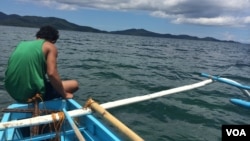The Philippines and China are locked in a territorial dispute in the South China Sea. In recent years, Beijing has sent forces to occupy reefs claimed by Manila and boats from both countries have engaged in stand offs in those waters. The island of Palawan in the west Philippines is at the forefront of these tensions. Now, Manila is considering allowing the United States to base some of its own forces there.
As boats from the small fishing village of Macarascas head out into the waters of the South China Sea, off Palawan’s west coast, they pass by the Philippines’ Ulugan Bay navy base.
Village council leader Jane Villarin said she worries about the tensions between her country and China in what is known here as the West Philippines Sea. And for that reason, she does not mind having the base so close by.
“It’s protection for us. We live here in the West Philippines Sea, so that’s our fear. That’s why the naval, the Philippines navy is welcomed here because of that,” said Villarin.
Villarin added that she would welcome the American navy too.
Following the April summit between President Barack Obama and Philippines leader Benigno Aquino, that could become reality.
“Today I’m pleased that we are beginning an important new chapter in the relationship between our two countries and its starts with our security with the new defense cooperation agreement that was signed today,” said Obama during that trip.
The Enhanced Defense Cooperation Agreement, or EDCA, opens the door for American forces to rotate through existing Filipino military bases. That includes facilities at Oyster Bay, which is located within Palawan’s Ulugan Bay base.
Oyster Bay is located 160 kilometers from the disputed Spratly islands in the South China Sea. Manila says the Chinese military is building outposts on Filipino reefs in these waters and harasses its naval forces.
Lieutenant Colonel Ramon Zagala, chief public affairs officer for the Armed Forces of the Philippines, said the presently undeveloped Oyster Bay base is a promising site for American and Filipino forces to work together as outlined in the new defense pact.
“The very purpose of that base is to enhance our defense capabilities westward to the West Philippines Sea. Oyster Bay is one of those that we want to offer to the United States so we can develop it,” said Zagala.
Zagala added that if Washington accepts the offer, Oyster Bay would still be a Philippines’ military base and not an American one.
He said the development of the Ulugan or Oyster Bay facilities with U.S. help is not meant to provoke China.
“I think it is our right and it the duty of the Armed Forces of the Philippines to protect our interests. They should not see the development of Ulugan bay as a threat. We are merely protecting our interests and our sovereignty,” said Zagala.
In May, Chinese President Xi Jingping warned Southeast Asian countries not to form military alliances aimed at a third party. That has been read throughout the region as a message not to try to stop China’s advances into the South China Sea, especially with American help.
Some observers say the EDCA only agitates Beijing further.
Political analyst Richard Heydarian at Ateneo de Manila University said that after the Philippines lost the Scarborough Shoal to Chinese forces in 2012, the Aquino administration rushed to get the U.S. involved in the territorial dispute. He thinks the EDCA might have been left intentionally vague to persuade Washington to sign on now.
“There are multiple dimensions to the EDCA that show the Philippines negotiated with a weaker hand,” said Heydarian.
He said that includes what the U.S. role will actually be if Filipino and Chinese forces exchange fire, how any joint American and Filipino bases, like Oyster Bay, would be funded in the long term, and what environmental safeguards will be followed in developing such facilities.
Environmental protection is a top concern on Palawan, much of which is a designated conservation zone. Oyster Bay itself is home to a mangrove forest and a variety of wildlife, say advocates.
It is over these concerns that the Puerto Princesa city government opposes the expansion of the Ulugan and Oyster Bay bases.
Elizabeth Maclang, a national park superintendent for Puerto Princesa, said development would have a detrimental impact on local communities.
“If you cut the mangroves, it will greatly affect their livelihoods. In the event of human error, it will greatly affect all the resources that come from Ulugan Bay, it’s a fish spawning area also,” said Maclang.
But, Maclang said, if the Philippines armed forces decide that base development is a part of national security, there is little the local government can do to stop it.
Villarin, from the Macarascas community council, said she is also concerned about potential environmental damage. But she explained that for the people in this poor village, or barangay, the naval base expansion could bring in more jobs.
“It’s a sign of development in our barangay. Maybe more business to come, progress in our barangay,” said Villarin.
The development could still be halted. Opponents of the new U.S.-Philippines defense agreement have filed petitions in the Philippines’ Supreme Court. If the pact is ruled unconstitutional, then Oyster Bay might remain as it is.








